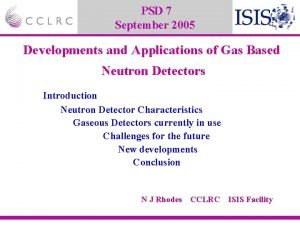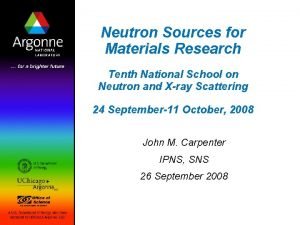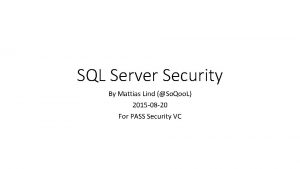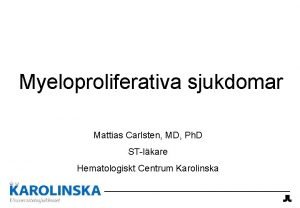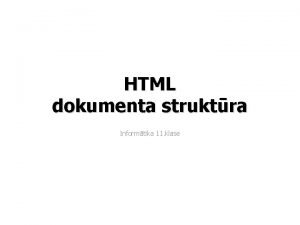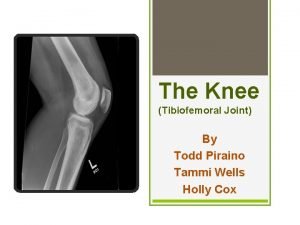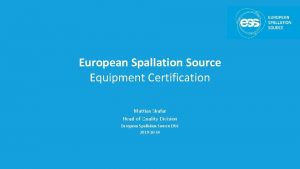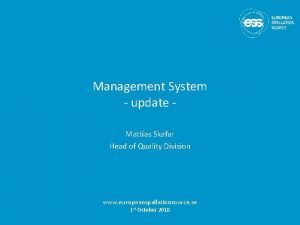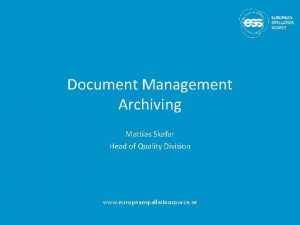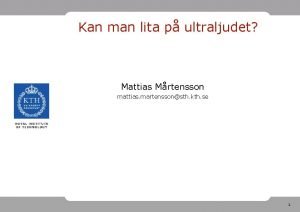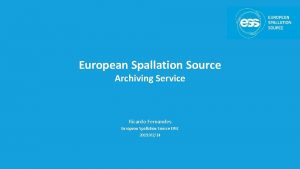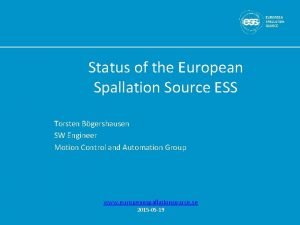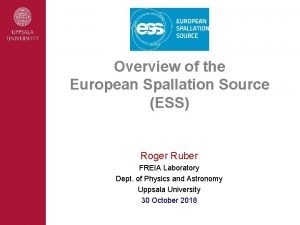European Spallation Source Equipment Certification Mattias Skafar Head





















- Slides: 21

European Spallation Source Equipment Certification Mattias Skafar Head of Quality Division European Spallation Source ERIC 2019 -05 -16

Equipment Certification at ESS Agenda • What is CE marking • How is it performed • Benefits and Challenges with CE 2

CE Marking Purpose and Meaning “There are two main benefits CE marking brings to businesses and consumers within the EEA*: • Businesses know that products bearing the CE marking can be traded in the EEA without restrictions. • Consumers(users) enjoy the same level of health, safety, and environmental protection throughout the entire EEA. CE marking also supports fair competition by holding all companies accountable to the same rules. *EEA – European Economic Area 3

CE Marking Manufacturers Process • Manufacturers are responsible for checking that their products meet EU safety, health and environmental protection requirements. • By affixing the CE marking to a product, a manufacturer declares* that the product meets all the legal requirements for CE marking and can be sold throughout the EEA. This also applies to products made in other countries that are sold in the EEA. ” *Note: In most cases performed as an self assessment, only notified body for equipment with specific requirements 4

CE Marking Legal requirements. . . the product meets all the legal requirements for CE marking. . . The product complies with all applicable EU directives! Active implantable medical devices Measuring instruments Medical devices Personal protective equipment Low voltage Pyrotechnics Explosives for civil uses Very diverse directives… In vitro diagnostic medical devices Construction products Non-automatic weighing instruments Eco-design of energy related products Equipment and protective systems intended for use potentially explosive atmospheres Low voltage Noise emission in the environment Appliances burning gaseous fuels Electromagnetic compatibility Simple pressure vessels Hot-water boilers Restriction of Hazardous Substances in Electrical and Electronic Equipment Pressure equipment Recreational craft Lifts Safety of toys Electromagnetic compatibility Restriction of Hazardous Substances in Electrical and Electronic Equipment Radio equipment Machinery ATEX Cableway installations designed to carry persons ATEX – ATmosphères EXplosives. 5

ESS Strategy for CE Marking • Approved by DG and ESS Management Team • The Strategy (ESS-0103087) applies to: – Internal deliverables – Commercial contracts – In-Kind Contributions • CE marking is mandatory. – when there is an applicable European Directive. • It states that deliveries shall include: – – Risk assessment (preferably according to ISO 12100) Technical File, drawings, wiring diagram, P&ID, etc. Operations Manual, in English Declaration of Conformity Ion Source INFN - LNS 6

The CE Marking process Six steps to compliance 7

Example for Machinery 1. Identify applicable Directives • Is CE marking necessary? – In some cases CE marking is not required, or even forbidden. – No applicable directives no CE marking • What Directive(s) applies? – Identify the scope • read definitions • ask fundamental questions – Identify the applicable directive(s) – Identify related Harmonised standards. Machinery Directive 2006/42/EC 8

Example for Machinery 2. Specific requirements (based on risks) Primary requirement: carry out risk assessment and design and build ‘machine’ accordingly Rest of Annex I: Guidance for RA and a long list of things to consider… 9

Example for Machinery Essential safety and health requirements, Annex 1 Section Topic / Requirement 1. 1. 2 Applicable / Not applicable / Fulfilled by… Section Topic / Requirement General Remarks 1. 5 Risk due to other hazards Definitions 1. 5. 1 Electricity supply Principles of safety integration 1. 5. 2 Static electricity Applicable / Not applicable / Fulfilled by… Example areas: • Control system • Protection against Mechanical Hazards • Guards and protective devices • Risks due to other hazards (el, fire etc. ) • Maintenance • Information For each applicable requirement of Annex I, 1. 1. 3 Materials and products 1. 5. 3 Energy supply other than electricity 1. 1. 4 Lighting 1. 5. 4 Errors of fitting 1. 1. 5 Design of machinery to facilitate its handling 1. 5. 5 Extreme temperatures 1. 1. 6 Ergonomics 1. 5. 6 Fire 1. 1. 7 Operating positions 1. 5. 7 Explosion 1. 1. 8 Seating 1. 5. 8 Noise 1. 2 Control Systems 1. 5. 9 Vibrations 1. 2. 1 Safety and reliability of control systems 1. 5. 10 Radiation 1. 2. 2 Control devices 1. 5. 11 External radiation 1. 2. 3 Starting 1. 5. 12 Laser radiation 1. 2. 4 Stopping 1. 5. 13 Emissions of hazardous materials and substances 1. 2. 5 Selection of control or operating modes 1. 2. 6 Failure of the power supply 1. 3 Protection against mechanical hazards 1. 3. 1 Risk of loss of stability 1. 3. 2 Risk of break-up during operation 1. 3. 3 Risks due to falling or ejected objects 1. 3. 4 Risk due to surfaces, edges or angles 1. 3. 5 Risks related to combined machinery 1. 3. 6 1. 3. 7 declare how you are fulfilling it, e. g. : 1. 5. 14 Risk of being trapped in a machine 1. 5. 15 Risk of slipping, tripping, falling • by using a harmonized standard • by using any other standard • by applying any specific solution fulfilling the state of the art 1. 5. 16 Lightning 1. 6 Maintenance 1. 6. 1 Machinery maintenance 1. 6. 2 Access to operating positions and servicing points 1. 6. 3 Isolation of energy sources 1. 6. 4 Operator intervention Risks related to variations in operating conditions 1. 6. 5 Cleaning of internal parts Risks related to moving parts 1. 7 Information 1. 3. 8 Choice of protection against risks arising from moving parts 1. 7. 1 Information and warnings on the machinery 1. 3. 9 Risks of uncontrolled movement 1. 7. 2 Warning of residual risks 1. 4 Required characteristics of guards and protective devices 1. 7. 3 Marking of machinery 1. 7. 4 Instructions 10

Example for Machinery 3. Rout to conformity • In rare cases a notified body needs to be brought in to act as a third party (see chapter 2 and Annex IV in MD (2006/42/EC)) • Obvious dangerous equipment • A typical case would be under Pressure Directive in certain classes • ISO 9001 certified companies • Most CE marking is done as self assessment 11

Example for Machinery 4. Test to verify conformity Test according to agreed test and inspection plan • Functional tests (FAT/SAT) • High voltage test • Non Destructive Testing – X-ray, Penetrant testing etc. • Measurements – Electrical, physical, Electro Magnetic Conductivity • Pressure test with fluids or gas 12

Example for Machinery 5. Compile the Technical Documentation – Technical File • Compile technical documentation – – – The technical file contains all documentation needed for the Declaration. Drawings, wiring diagrams, inspection plan, test reports This is the technical documentation needed in most cases anyway 13

ESS approach – step by step to compliance Instructions – Operations & Maintenance Manual • Operations & Maintenance Manual – Directives gives clear guidance on how t write – First issue needs to be released before a Do. C is signed. Living document. – All official documentation shall be written in English (will be translated to Swedish if needed) – Fines from Work authority for not having manuals 14

Example for Machinery 6. Issue Declaration of Conformity • Produce a Declaration of Conformity(Do. C) – – • Produce a Do. C according to applicable directive(s) Do. C needs to be signed by a person appointed by Highest Manager or him/herself Produce and affix the CE-sign – – – CE-Sign needs to be produced according to applicable directive(s) CE-sign needs to be permanently affixed to the equipment, In cases of Machinery, blind rivet is preferred. 15

How is CE marking performed Example • Type of delivery: – – In house design In-kind Contribution External provider Of the shelf, CE marked Declaration of Conformity* ESS/IKC Partner institute Supplier * Declaration of Conformity for part of machine (to be incorporated) or a complete machine 16

ESS CE marking project Performed: • Ion Source & LEBT Ongoing: • Stub lift – Acc. • Lifting device for Waveguides – Acc. • RFQ – Acc. • 70 ton sliding shielding door – TS 2 • Welding robot – NSS • Spider cage – NSS • Etc… Italian President and Swedish King inaugurates the ion source during the Italian State visit to Sweden. 17

Result Ion Source and LEBT • • • Updated general risk assessment after delivery and assembly at site High voltage test performed (1, 2 times working load) Improved EMC shielding Improved grounding Risk assessment with specific focus on ATEX* ATEX zones defined and established Hydrogen bottle moved to zone Re-design of Hydrogen piping Installation of permanent Hydrogen alarm Issuing of Hydrogen bottle exchange procedure ATEX – ATmosphères EXplosives. 18

Challenges and Benefits with CE marking Challenges • ESS has a multitude of interfaces – Both internal and external (and a mix) • ESS has a very large proportion of In-kind deliverables • Sometimes unclear who has the overall responsibility in deliveries • The CE marking approach is still not obvious in the Research community Benefits • Equipment is made as safe as possible – by the manufacturer • Remaining risks are known and exposed to user • Documentation (Technical file) is compiled and easily accessible • Compliant to European Directives – if anything happens 19

Conclusion • CE marking is very useful in projects with many interfaces – Everybody takes responsibility for their deliverable – Easier for the receiving party to get and overall picture – Better structure on technical documentation • Six steps to follow • Benefits: – Early identified risks can be mitigated already in the design – Manufacturer owns its own risks – Many of the task that will be done anyway is done with a clear structure – Compliant to relevant directives – Higher safety, availability and maintainability 20

Thank YOU for your time! 21
 Spallation neutron source
Spallation neutron source Spallation neutron source
Spallation neutron source Neutron fission
Neutron fission Cristian massimi unibo
Cristian massimi unibo Branko škafar
Branko škafar Mattias carlsten
Mattias carlsten Autolog stamcellstransplantation
Autolog stamcellstransplantation Mattias klawitter
Mattias klawitter Mattias sql
Mattias sql Mattias arvola
Mattias arvola Mattias blennow
Mattias blennow Polycytemia vera livslängd
Polycytemia vera livslängd Mattias marklund
Mattias marklund European cybersecurity certification group
European cybersecurity certification group 40:1 dividing head chart
40:1 dividing head chart The attacking firm goes head-to-head with its competitor.
The attacking firm goes head-to-head with its competitor. Tagi html
Tagi html Disk
Disk Body parts
Body parts What is a stressed syllable
What is a stressed syllable Negative suction head
Negative suction head Long head short head bicep
Long head short head bicep
